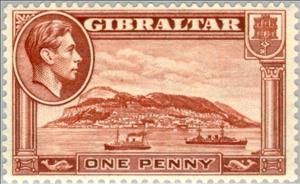Stamp: Rock of Gibraltar (Gibraltar 1938)
Rock of Gibraltar (Gibraltar 1938)
01 January (Gibraltar ) within release King George VI and Views goes into circulation Stamp Rock of Gibraltar face value 1 Gibraltar penny
| Stamp Rock of Gibraltar in catalogues | |
|---|---|
| Michel: | Mi:GI 108B |
Stamp is horizontal format.
Also in the issue King George VI and Views:
- Stamp - Government House face value 5;
- Stamp - King George VI face value 1;
- Stamp - Southport Gate face value 1;
- Stamp - King George VI face value ½;
- Stamp - Rock of Gibraltar face value 1;
- Stamp - The Rock North Side face value 2;
- Stamp - Europa Point face value 3;
- Stamp - Moorish Castle face value 6;
- Stamp - Elliott Memorial face value 2;
|
Data entry completed
83%
|
|
|---|---|
| Stamp Rock of Gibraltar in digits | |
| Country: | Gibraltar |
| Date: | 1938-01-01 |
| Size: | 41 x 26 |
| Perforation: | 14 |
| Emission: | Definitive |
| Format: | Stamp |
| Face Value: | 1 Gibraltar penny |
Stamp Rock of Gibraltar it reflects the thematic directions:
A landscape is the visible features of an area of land, its landforms and how they integrate with natural or man-made features. A landscape includes the physical elements of geophysically defined landforms such as (ice-capped) mountains, hills, water bodies such as rivers, lakes, ponds and the sea, living elements of land cover including indigenous vegetation, human elements including different forms of land use, buildings and structures, and transitory elements such as lighting and weather conditions. Combining both their physical origins and the cultural overlay of human presence, often created over millennia, landscapes reflect a living synthesis of people and place that is vital to local and national identity. The character of a landscape helps define the self-image of the people who inhabit it and a sense of place that differentiates one region from other regions. It is the dynamic backdrop to people’s lives. Landscape can be as varied as farmland, a landscape park, or wilderness. The earth has a vast range of landscapes, including the icy landscapes of polar regions, mountainous landscapes, vast arid desert landscapes, islands and coastal landscapes, densely forested or wooded landscapes including past boreal forests and tropical rainforests, and agricultural landscapes of temperate and tropical regions.
A ship is a large watercraft that travels the world's oceans and other sufficiently deep waterways, carrying passengers or goods, or in support of specialized missions, such as defense, research and fishing. Historically, a "ship" was a sailing vessel with at least three square-rigged masts and a full bowsprit. Ships are generally distinguished from boats, based on size, shape and load capacity.
These clams live buried in the sediment on tidal flats. While they are common in muddy areas, their name "arenaria" means sandy and they prefer a combination of sandy and muddy areas. They are well known as a food item on the coast of New England in the Western Atlantic Ocean; however, the range extends much farther north to Canada and south to the Southern states. They are also found in the Eastern Atlantic Ocean, for example in the UK, as well as in the North Sea's Wadden Sea (where they are the dominant large clam).
A vehicle (from Latin: vehiculum) is a mobile machine that transports people or cargo. Typical vehicles include wagons, bicycles, motor vehicles (motorcycles, trucks, buses), railed vehicles (trains, trams), watercraft (ships, boats), aircraft and spacecraft. Land vehicles are classified broadly by what is used to apply steering and drive forces against the ground: wheeled, tracked, railed or skied. ISO 3833-1977 is the standard, also internationally used in legislation, for road vehicles types, terms and definitions.
A coat of arms is an heraldic visual design on an escutcheon (i.e. shield), surcoat, or tabard. The coat of arms on an escutcheon forms the central element of the full heraldic achievement which in its whole consists of shield, supporters, crest, and motto. A coat of arms is traditionally unique to an individual person, family (except in the United Kingdom), state, organisation or corporation.





